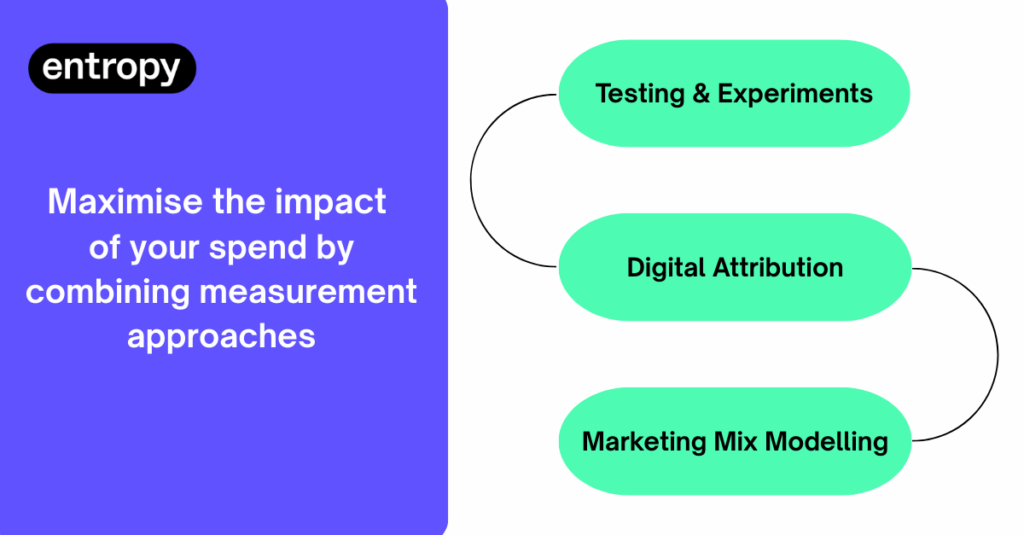Expectation vs Reality of Marketing Measurement
Marketing measurement has always been a challenge, but the rise of digital marketing has created an expectation that everything should be perfectly attributable. After all, if we have access to vast amounts of digital data, surely we should be able to pinpoint exactly what’s driving results?
At the same time, traditional advertising has historically been seen as hard to measure, yet it demands significant investment. Measuring the impact of a TV campaign, an out-of-home placement, or even a sponsorship deal is far less straightforward than logging into a dashboard
Related to that is the bigger balancing act: short-term revenue vs. long-term brand building. In theory it’s easier to prove the impact of a performance marketing campaign that drives immediate conversions, than to attribute value to long-term brand perception shifts.
The Growing Challenges of Tracking
If a large part of digital marketing’s appeal was its measurability, recent changes have made things more complicated. Privacy regulations, third-party cookie deprecation, and platform tracking limitations have significantly eroded marketers’ ability to track user journeys accurately.
Even once-reliable digital attribution models now face increasing blind spots. The platforms themselves are working on solutions (such as modelled conversions), but these often lack transparency, making it harder for marketers to fully trust their data.
It can feel that John Wanamaker’s famous quote is still as relevant today as it always has been: “Half the money I spend on advertising is wasted; the trouble is, I don’t know which half”. But actually, with a modern measurement strategy this doesn’t have to be the case.
The Rise of AI-Driven “Silver Bullet” Solutions
With AI now a mainstream buzzword, there’s been an explosion of SaaS providers claiming to have “the” measurement solution – again, particularly for digital media. These tools often promise precise, AI-driven attribution, positioning themselves as the single answer to tracking challenges.
But marketing measurement isn’t something that can be solved by one tool alone. While AI has undoubtedly enhanced measurement capabilities, any provider claiming to offer a one-size-fits-all solution is oversimplifying a much more complex reality.
No digital attribution tool for example is taking into account your out-of-home or TV campaigns, nor the impact of seasonality, discounting, or your brand equity – all of which we know impacts the performance of your digital campaigns.
Another issue here is the lack of transparency in the methodology that you often see with AI-driven measurement solutions, making it difficult for stakeholders to truly understand, and trust, the results they are presented with.
Three Pillars of Holistic Measurement
Instead of looking for a silver bullet, brands should adopt a multi-faceted approach to measurement which accounts for different types of marketing and their respective strengths and limitations.

A holistic strategy includes:
1. Digital Attribution
Despite the limitations described above, this does provide an always-on view on the relative performance of different digital campaigns in the short-term. When used in combination with the other approaches outlined here it is still a powerful tool to ensure timely optimisations for your immediate revenue driving campaigns.
2. Testing and Experimentation
Platform-based tests (such as holdout tests or geo-experiments) provide relatively controlled environments to assess the effectiveness of a campaign or type of media. By their nature the findings are focussed on one variable, but they are a good entry point to marketing measurement whilst reducing risk.
3. Marketing Mix Modelling (MMM)
You can read more about MMM here. Essentially it is a statistical method for determining the relationship between your performance drivers and your KPI (usually sales). MMM captures the impact of performance drivers including media (paid and otherwise) as well as external variables such as seasonality and consumer confidence. It can also account for changes in your other marketing fundamentals such as pricing and distribution.
MMM has historically been reserved for larger brands due to its cost and labour-intensive nature, but it is becoming increasingly cost-effective and quick thanks to advances in technology. It provides a statistically rigorous calibration of macro performance and suggested budgets for different media types, that complements the always-on nature of the other forms of measurement outlined above.
You can get in touch here to see if Marketing Mix Modelling may be of use to your business.
Each of these approaches complements the others, providing a clearer, more balanced picture of marketing effectiveness.
Why This Approach is a Journey, Not a Quick Fix
Building a robust measurement strategy doesn’t happen overnight. Other than the budgetary considerations, it only works with organisational buy-in, and often a cultural shift in how marketing effectiveness is understood, particularly for digital-first teams.
Take Marketing Mix Modelling (MMM) as an example. Many MMM practitioners report that one of the biggest barriers to adoption isn’t the methodology itself – it’s that stakeholders don’t believe the results. When MMM findings challenge existing assumptions or contradict platform-reported data, it can be difficult for teams to accept.
This is why education and internal advocacy are just as important as the measurement itself. A successful approach involves not just running the models, but also aligning teams around the insights they generate.
Indeed to this end we often run MMM induction sessions with clients to take stakeholders through how the model is built.
No Single Answer, but a Smarter Approach
There’s no single tool or methodology that will solve the challenges of marketing measurement. Instead, brands should focus on building a balanced, multi-layered approach that leverages the strengths of different methodologies, focusing on those that will be the most impactful for their specific needs.
If your measurement strategy relies too heavily on one method, it may be time to broaden your approach. And if you’ve been sold on an AI-powered silver bullet, it’s worth asking whether it truly accounts for the full complexity of marketing impact.
The key isn’t finding “the” answer; it’s using multiple lenses to continue to work towards the best possible answer.


